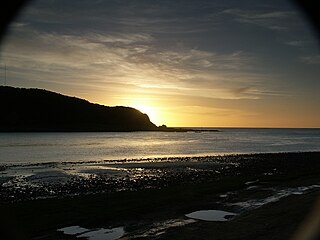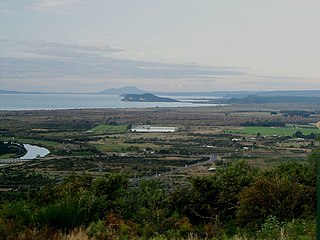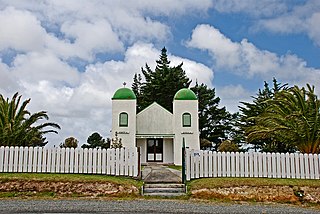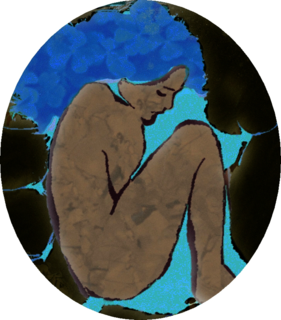In Māori mythology, Rongo or Rongo-mā-Tāne is a major god (atua) of cultivated plants, especially kumara, a vital crop. Other crops cultivated by Māori in traditional times included taro, yams (uwhi), cordyline (tī), and gourds (hue). Because of their tropical origin, most of these crops were difficult to grow except in the far north of the North Island, hence the importance of Rongo in New Zealand.

In Māori mythology the primal couple Rangi and Papa appear in a creation myth explaining the origin of the world. In some South Island dialects, Rangi is called Raki or Rakinui.

In Cook Islands mythology, Avatea was a lunar deity and the father of gods and men in Mangaian myth of origin. His eyes were thought to be the sun and the moon; he was also known as the god of light.

The Treaty of Waitangi is a treaty first signed on 6 February 1840 by representatives of the British Crown and Māori chiefs (rangatira) from the North Island of New Zealand. It is a document of central importance to the history and political constitution of the state of New Zealand, and has been highly significant in framing the political relations between New Zealand's government and the Māori population.
In Polynesian mythology, Hawaiki is the original home of the Polynesians, before dispersal across Polynesia. It also features as the underworld in many Māori stories.

Ngāpuhi is a Māori iwi located in the Northland region of New Zealand, and centred in the Hokianga, the Bay of Islands, and Whangarei.

Ngāti Whātua is a Māori iwi (tribe) of the lower Northland Peninsula of New Zealand's North Island. It comprises a confederation of four hapū (subtribes) interconnected both by ancestry and by association over time: Te Uri-o-Hau, Te Roroa, Te Taoū, and Ngāti Whātua-o-Ōrākei. The four hapū can act together or separately as independent tribes.

Ngāti Toa, Ngāti Toarangatira or Ngāti Toa Rangatira, is a Māori iwi (tribe) in the lower North Island and upper South Island of New Zealand. Its rohe extends from Whanganui in the north, Palmerston North in the east, and Kaikoura and Hokitika in the south. Ngāti Toa remains a small iwi with a population of only about 4500. It has four marae: Takapūwāhia and Hongoeka in Porirua, and Whakatū and Wairau in the north of the South Island. Ngāti Toa's governing body has the name Te Rūnanga o Toa Rangatira.

Mangaia is the most southerly of the Cook Islands and the second largest, after Rarotonga.
The Japanese Sign Language syllabary is a system of manual kana used as part of Japanese Sign Language (JSL). It is a signary of 45 signs and 4 diacritics representing the phonetic syllables of the Japanese language. Signs are distinguished both in the direction they point, and in whether the palm faces the viewer or the signer. For example, the manual syllables na, ni, ha are all made with the first two fingers of the hand extended straight, but for na the fingers point down, for ni across the body, and for ha toward the viewer. The signs for te and ho are both an open flat hand, but in te the palm faces the viewer, and in ho it faces away.

Ngāti Tūwharetoa is an iwi descended from Ngātoro-i-rangi, the priest who navigated the Arawa canoe to New Zealand. The Tūwharetoa region extends from Te Awa o te Atua at Matata across the central plateau of the North Island to the lands around Mount Tongariro and Lake Taupo.

Te Aupōuri is the second northernmost Māori iwi, located north of Kaitaia, Northland, New Zealand, a region known as the Te Hiku o te Ika. The iwi is one of the six Muriwhenua iwi of the far north of the North Island.

"Te Atua mou ē" is the national anthem of the Cook Islands. It was adopted in 1982, replacing the previous New Zealand anthem "God Defend New Zealand".

Ngāti Awa is a Māori iwi (tribe) centred in the eastern Bay of Plenty Region of New Zealand. It is made of 22 hapu (subtribes), with 15,258 people claiming affiliation to the iwi in 2006. The Ngāti Awa people are primarily located in towns on the Rangitaiki Plain, including Whakatane, Kawerau, Edgecumbe, Te Teko and Matata. Two urban hapu also exist in Auckland and Wellington.
In music, counting is a system of regularly occurring sounds that serve to assist with the performance or audition of music by allowing the easy identification of the beat. Commonly, this involves verbally counting the beats in each measure as they occur. In addition to helping to normalize the time taken up by each beat, counting allows easier identification of the beats that are stressed. Counting is most commonly used with rhythm and form and often involves subdivision.
In Cook Islands mythology, Tumu-te-ana-oa was the female personification of Echo. She was the fourth child of Vari, the primordial mother goddess. Both her name and the land she occupied had to do with the production of echoes. Her name means "the cause (tumu) of the call or voice (oa) heard from caves (ana)". The term oa is used by people when calling out to evoke an echo. Her land was Te Parae-tea, which Gill translates, "The-hollow-gray-rocks". Mamae gives no more detail, but Gill recounts that Tumu-te-ana-oa frequented the caves of Mangaia, where she was seen by Rangi, one of the first inhabitants. The cave in which she was first seen was Aitu-mamaoa.
In Cook Islands mythology, Raka (Trouble) was the god of winds and storms. He was the fifth child of the Great Mother, Vari. Raka found a congenial home in Moana-Irakau. According to Gill, Raka received from Vari a great basket, in which contained the hidden winds, as well as the knowledge of many useful inventions. The children of Raka are the numerous winds and storms which distress mankind. Each child was assigned a hole in the horizon through which he blew at pleasure. Gill's informant, Mamae, gives his wife and children but not the parents of the wife, Takatipa; whoever they were, they formed additional contemporaries of Vari.
In Cook Islands mythology, Tango (Support) was the third child of the primordial mother goddess, Varima-te-takere. He was assigned to live at Enua-kura. According to Mamae, Gill's informant, Tango was the progenitor of a skilled fishing family. That the six grandsons of Tango were good workers is shown in the native text. The enclosure (akeke) for fish mentioned in a chant has not been retained in the local culture of the people.
Hina-Oio is a goddess of the sea animals in the mythology of Easter Island. She was married to Atua-Metua and represented the mother of all animals of the sea.












